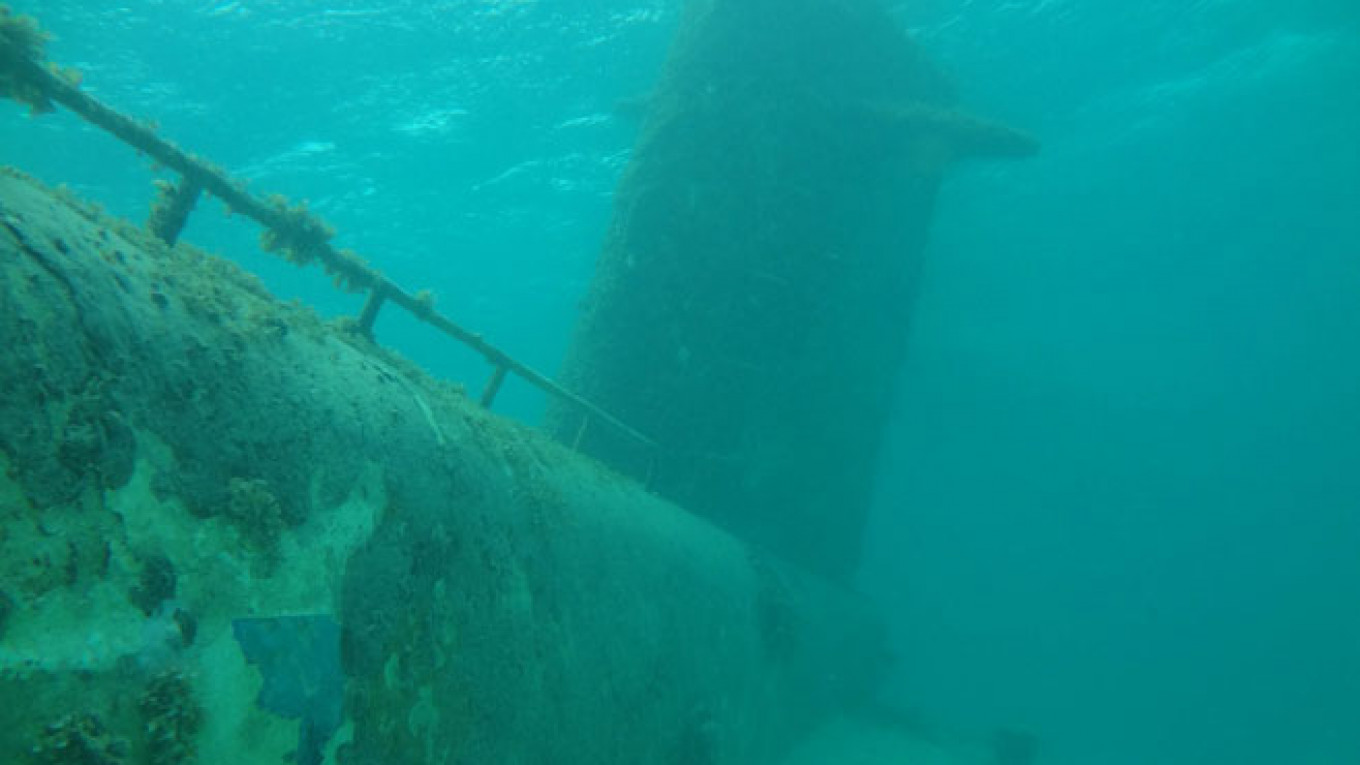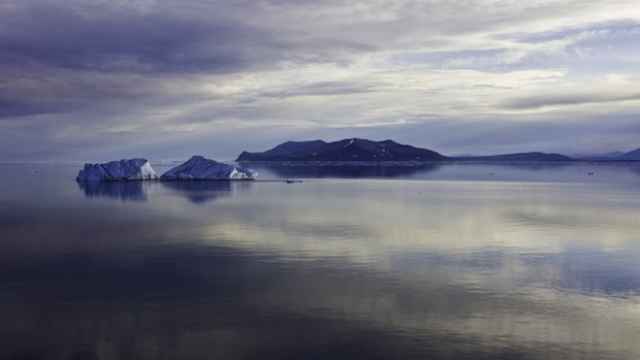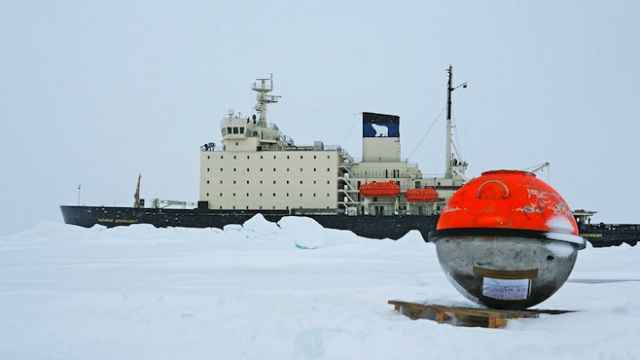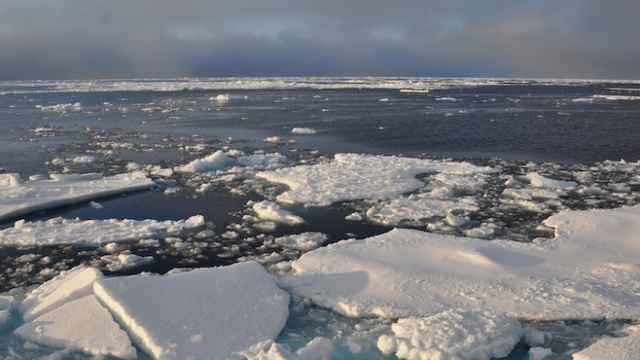Three Soviet-era nuclear submarines currently lie at the bottom of the Arctic Ocean. The Soviet Union and the United States both lost submarines to the ocean depths during the Cold War, but their environmental impact is either negligible or unknown. Meanwhile, the three submarines in the Arctic are known to be environmental hazards by virtue of the way in which they were sunk and the condition of their hulls.
K-27
Type: Specially modified November-class submarine, only one of its class.
Launched: April 1, 1962
Sunk: Scuttled on Sept. 6, 1982
Footage taken by a mini-submarine in 2012 of the K-27 submarine's hull. (Norwegian Radiation Protection Authority)
The K-27 was scuttled of the coast of Novaya Zelmya in 50 meters of water in 1982. It contained 90 kilograms of uranium-235 when it went down.
An experimental derivative of the standard November-class submarine, the K-27 set to sea on a 70-day tour in 1968.
The voyage, meant to showcase the Soviets' command of nuclear technology, ended in tragedy.
A mere three days into its voyage, a radiation leak from one of its two reactors began to poison the crew. The captain defied orders to cut the engines and wait for help, knowing that every minute aboard the hazardous vessel would jeopardize the lives of his 144-man crew.
Nine of the K-27's crew would die soon after, and many would succumb to radiation induced illnesses in the years to follow.
Various attempts were made to repair or replace her reactors over the next 10 years, but in 1979 the navy finally gave up and decommissioned the ship. Too radioactive to dismantle properly, the Soviets towed her out to a military test range on the Kara Sea three years later and scuttled her in a fjord.
It reportedly didn't go down easy. Initial attempts to scuttle the K-27 were complicated by the shallow waters. When the submarine's bow hit the bottom, the shallow depth forced the submarine's rear to jut out of the ocean surface. In order to finish the submarine off, a barge had to charge the aft ballast tank and ram open a hole.
The K-27 was filled with concrete and asphalt to seal the two reactors and their fuel, a measure meant to stave off any environmental fallout for 50 years. With less than 20 years left before the expiration date, the clock is ticking.
Whats worse, the K-27's reactors are in danger of generating an uncontrolled nuclear chain reaction, prompting many environmentalists and Arctic observers to call for the submarine's retrieval from the Kara Sea floor.
K-159
Type: November-class
Launched: June 6, 1963
Sunk: Aug. 30, 2003
Video taken by a Russian-Norwegian survey team investigating the condition of the K-159's hull and radiation levels around the wreck in September 2014. (Norwegian Radiation Protection Authority)
The K-159's entire propulsion system became irradiated in 1965 after a coolant leak. Over the next 15 years it underwent various repair jobs, and was eventually taken out of service altogether in 1989.
The submarine rusted until 2003, when the state of her hull was so bad that four pontoons had to be spot welded to its hull in order to keep it afloat while being towed to the town of Polyarny for dismantling.
While underway, 10 sailors had to be stationed aboard to pump water out and close up leaks, but a storm hit and ripped one of the pontoons off, and the ship went down with nine of the 10 sailors and an estimated 800 kilograms of spent nuclear fuel — making it one of the most dangerous potential sources of radiation in the Arctic.
The K-159 is significantly harder to salvage than the K-27 by virtue of depth — over 200 meters.
In October 2013, Ingar Amundsen of the Norwegian Radiation Protection Authority told the Barents Observer that the "K-159 represents the biggest potential for emission, considering the levels of radioactivity in the reactors, compared with other dumped or sunken objects in the Kara Sea with spent nuclear fuel or radioactive wast."
Although authorities have downplayed the threat of the submarine, claiming it poses no imminent danger, video shows a porous hull, and in May, the Bellona Foundation reported radiation readings that are 1.5 times higher than other nuclear wrecks.
K-278
Type: Mike-class nuclear attack submarine, only one of its class.
Launched: May 9, 1983
Sunk: April 7, 1989
The Komsomolets was another experimental soviet nuclear submarine. A novel design featuring two titanium hulls — one inside the other — gave the submarine the ability to dive deeper than any U.S. submarines.
On April 7, 1989, the Komsomolets sank after a fire broke out in its engine room, crippling the ship.
The submarine settled in an area of the Barents Sea that is considered to be one of the world's largest fishing areas, accounting for billions of dollars of fishing annually, according to a report by the Federation of American Scientists.
Concerns about contamination of the area from the submarine's nuclear reactor have not yet given way to an actual environmental crisis. In the mid 1990s, after proposals to lift the submarine were estimated to cost $1 billion and entailed risk of damaging the submarine further, Russian engineers proposed hermetically sealing large cracks in the submarine's hull with a type of jelly.
A series of expeditions conducted in the mid-1990s successfully sealed the openings in the Komsomolets, and environmental readings taken as recently as 2008 have shown no indication of a radiation leak.
However, the jelly seals were estimated to provide 20 to 30 years of protection. Russian authorities have said that the submarine poses no radiological threat before 2015 or 2025, news agency RIA Novosti reported in 2007.
A Message from The Moscow Times:
Dear readers,
We are facing unprecedented challenges. Russia's Prosecutor General's Office has designated The Moscow Times as an "undesirable" organization, criminalizing our work and putting our staff at risk of prosecution. This follows our earlier unjust labeling as a "foreign agent."
These actions are direct attempts to silence independent journalism in Russia. The authorities claim our work "discredits the decisions of the Russian leadership." We see things differently: we strive to provide accurate, unbiased reporting on Russia.
We, the journalists of The Moscow Times, refuse to be silenced. But to continue our work, we need your help.
Your support, no matter how small, makes a world of difference. If you can, please support us monthly starting from just $2. It's quick to set up, and every contribution makes a significant impact.
By supporting The Moscow Times, you're defending open, independent journalism in the face of repression. Thank you for standing with us.
Remind me later.






